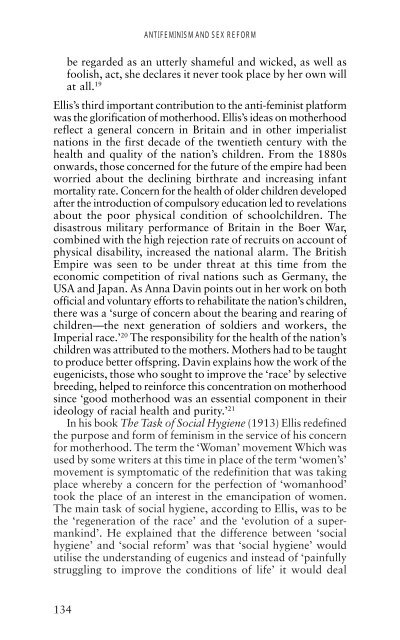The Spinster and Her Enemies - Feminish
The Spinster and Her Enemies - Feminish
The Spinster and Her Enemies - Feminish
You also want an ePaper? Increase the reach of your titles
YUMPU automatically turns print PDFs into web optimized ePapers that Google loves.
ANTIFEMINISM AND SEX REFORM<br />
be regarded as an utterly shameful <strong>and</strong> wicked, as well as<br />
foolish, act, she declares it never took place by her own will<br />
at all. 19<br />
Ellis’s third important contribution to the anti-feminist platform<br />
was the glorification of motherhood. Ellis’s ideas on motherhood<br />
reflect a general concern in Britain <strong>and</strong> in other imperialist<br />
nations in the first decade of the twentieth century with the<br />
health <strong>and</strong> quality of the nation’s children. From the 1880s<br />
onwards, those concerned for the future of the empire had been<br />
worried about the declining birthrate <strong>and</strong> increasing infant<br />
mortality rate. Concern for the health of older children developed<br />
after the introduction of compulsory education led to revelations<br />
about the poor physical condition of schoolchildren. <strong>The</strong><br />
disastrous military performance of Britain in the Boer War,<br />
combined with the high rejection rate of recruits on account of<br />
physical disability, increased the national alarm. <strong>The</strong> British<br />
Empire was seen to be under threat at this time from the<br />
economic competition of rival nations such as Germany, the<br />
USA <strong>and</strong> Japan. As Anna Davin points out in her work on both<br />
official <strong>and</strong> voluntary efforts to rehabilitate the nation’s children,<br />
there was a ‘surge of concern about the bearing <strong>and</strong> rearing of<br />
children—the next generation of soldiers <strong>and</strong> workers, the<br />
Imperial race.’ 20 <strong>The</strong> responsibility for the health of the nation’s<br />
children was attributed to the mothers. Mothers had to be taught<br />
to produce better offspring. Davin explains how the work of the<br />
eugenicists, those who sought to improve the ‘race’ by selective<br />
breeding, helped to reinforce this concentration on motherhood<br />
since ‘good motherhood was an essential component in their<br />
ideology of racial health <strong>and</strong> purity.’ 21<br />
In his book <strong>The</strong> Task of Social Hygiene (1913) Ellis redefined<br />
the purpose <strong>and</strong> form of feminism in the service of his concern<br />
for motherhood. <strong>The</strong> term the ‘Woman’ movement Which was<br />
used by some writers at this time in place of the term ‘women’s’<br />
movement is symptomatic of the redefinition that was taking<br />
place whereby a concern for the perfection of ‘womanhood’<br />
took the place of an interest in the emancipation of women.<br />
<strong>The</strong> main task of social hygiene, according to Ellis, was to be<br />
the ‘regeneration of the race’ <strong>and</strong> the ‘evolution of a supermankind’.<br />
He explained that the difference between ‘social<br />
hygiene’ <strong>and</strong> ‘social reform’ was that ‘social hygiene’ would<br />
utilise the underst<strong>and</strong>ing of eugenics <strong>and</strong> instead of ‘painfully<br />
struggling to improve the conditions of life’ it would deal<br />
134

















